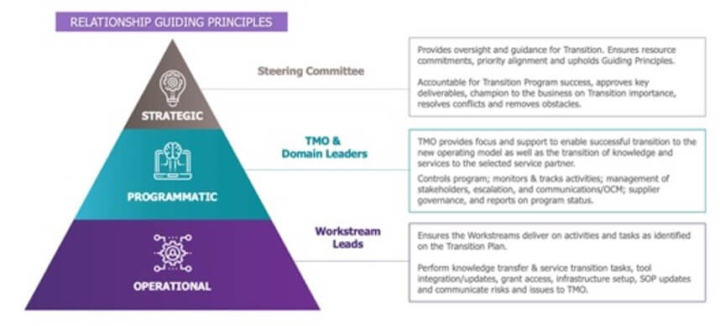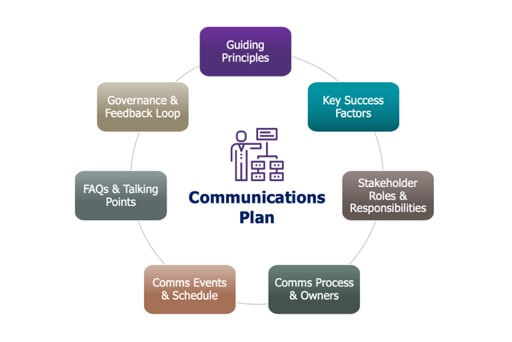Managed Services Outsourcing continues to be a valuable strategy for IT organizations looking to control and reduce costs, dispense with low-value operations and maintain focus on core capabilities that enhance business results. Yet despite these benefits, the journey and transition to outsourcing is not an easy process: according to Dunn & Bradstreet’s Barometer of Global Outsourcing, “20 – 25% of all outsourcing relationships fail within two years”. While a lot of care is typically taken on the evaluation, selection and contracting aspects of an outsourcing transaction, the Transition phase is often discounted as being the new service provider’s job to figure out. In fact, how well the Transition is conducted by both parties has a high correlation to the success of the long-term relationship.
Unless you are simply extending the term of your existing contract, Transition is always a factor to be managed. A first-time outsourcing is obviously a major change event that requires intensive planning and oversight. So is switching service providers in a re-compete. But even renewals with an incumbent can entail significant complexity. Why? Because the client will demand that the old agreement be brought up to contemporary standards (increased automation, scope adjustments, better pricing, improved service levels), otherwise why not open the deal to competition? In response, the incumbent provider must transform their solution and services to meet these requirements. This transformation usually involves changes in how the client interacts with the services and the provider… and voila! a Transition to be managed.
Case in point: Wavestone recently managed the Transition for a client-service provider contract x`renewal, and that program was 20 weeks in duration. From the client’s perspective, the CIO truly appreciated that a smooth Transition with the service provider has enabled a transformation of the relationship from frustration to collaboration.
Transition Success Factors
When Transitions run into problems, the underlying causes typically stem from a lack of detailed Transition planning and execution management. In our experience, the most frequent factors that have led to problematic Transitions include the following:
- Lack of thorough knowledge transfer
- Vendor underestimated scope & effort
- Retained organization role confusion
- Attrition of key resources
- Missed Transition dates for service areas
- Lack of service level attainment
- Ineffective operating model & support gaps
- Process disconnects between multiple service providers
Wavestone helps clients plan and manage these challenges at all stages of the Managed Services Outsourcing process lifecycle. That’s an important concept to highlight, because the work of Transition planning shouldn’t be left until the last minute when the contract is being signed. Borrowing from the old saying “Begin with the end in mind”, Transition Management should be initiated from the outset, especially when it comes to impacts on the organization and key retained staff members. As we will unpack below, getting ahead of Transition planning will help maximize your speed to Transition, service quality and value, while minimizing risk and business disruption.
Our Transition Lifecycle Approach
To help clients successfully transition an Outsourcing transaction, Wavestone consultants organize the program into a four-phased Transition process. When planning your next Transition, you can consider adopting our lifecycle approach and the key actives by phase listed below:
Phase 1 – Planning
- Understand Scope, Complexity and Workstreams
- Organize Transition Management Office & Team
- Build/Review Transition Plan
- Develop Organizational Change Management Plan
- Establish Transition Steering Committee
Phase 2 – Transition Management
- Facilitate Transition Kickoff
- Manage Transition Plan & Status
- Manage Risks, Issues, Actions & Escalation Management
- Manage Communications Plan
- Develop Supplier Governance
- Facilitate Transition Steering Committee Meetings
Phase 3 – Steady State
- Validate Operational Readiness
- Implement Governance Model
- Baseline & Operationalize SLAs, Budget, Billing and Reporting
- Manage Transition Plan & Status
- Manage Communications Plan
Phase 4 – Close Out
- Facilitate Company and Supplier Transition Sign-off
- Ensure End-to-End Integration of Process Changes & Service Continuity
- Confirm Post-Transition Reporting
- Governance Model Fully Operational
- Finalize Organization & Operating Model Communications
- Confirm Contract Obligations & Deliverables
Transition Management Office
Having a well-structured Transition plan is necessary, but not sufficient. Managing to that plan is key to a successful Transition. We strongly recommend that our clients stand up a Transition Management Office (TMO) to manage the lifecycle activities. The TMO is responsible for ensuring:
- All Stakeholders Identified
- Clear Roles & Responsibilities Established throughout Transition
- Comprehensive Transition Plan Developed & Managed
- Effective Transition Governance Implemented
- Escalation Management In Place
- Organizational Change Management
Transition Management Office Structure
Organizational Change Management
Sometimes clients are tempted to regard the Transition Management Office as a glorified PMO for the transition. While managing activities and issues is clearly necessary, managing Change is equally important. As part of the Transition Management Office, the creation of the Organizational Change Management (OCM) process needs to be in place to help establish the plan and governance model to address change management and communications needs throughout the Transition lifecycle.
The OCM process builds shared understanding, defines client, service provider and stakeholder alignment; and lays out the detailed communications strategy for key Transition events, service transition and the new operating model.
Organizational Change Management
Conclusion
Service providers will try to sell you on their ability to manage the Transition for you: teams of dedicated Transition Managers, experience transitioning multiple clients representing umpteen $Billion in revenue, a repeatable methodology, etc. While this may be true (and it’s a good thing they are well-prepared to manage their role in the Transition process), you, the client, are ultimately going to have to live with the results. We therefore recommend you remain in control of this process.
Clients who are facing a transition (or transformation) of their IT or business processes to an outsourcing service provider will greatly benefit from adopting the four-phased Transition Lifecycle approach, establishing a Transition Management Office, and structuring an effective Organization Change Management plan. These proven approaches will provide the necessary planning, management and focus required for you to execute a successful transition and establish a firm foundation for a beneficial outsourcing relationship.
Have a question? Just Ask.
Whether you're looking for practical advice or just plain curious, our experienced principals are here to help. Check back weekly as we publish the most interesting questions and answers right here.





